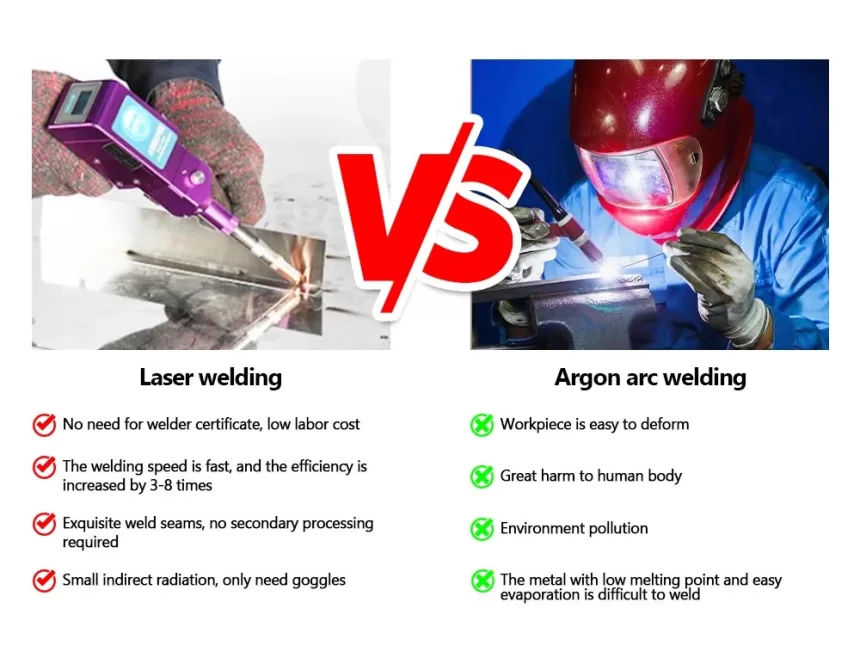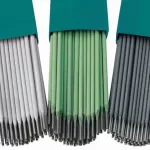Arc welding and laser welding are two prominent welding methods used in many industries for joining metal components. While both techniques serve to create strong and durable welds, they differ significantly in several aspects. This article explores the key differences between arc welding and laser welding, focusing on the heat source, equipment, speed, power, and other essential factors that impact their performance.
Arc Welding vs. Laser Welding: The Key Differences
Welding Town
What Is Arc Welding?
Arc welding is a welding process that uses an electric arc to join metals. Portions of the metal components receive a continuous electrical discharge known as an arc that bridges the gap between an electrode (a consumable or non-consumable metal rod) and the workpiece. The heat generated by the arc melts the metals, forming a weld pool of material from both pieces. When the pool solidifies, it creates a strong joint.
There are several types of arc welding processes, including: Shielded Metal Arc Welding (SMAW), Gas Metal Arc Welding (GMAW), Flux-Cored Arc Welding (FCAW), and Gas Tungsten Arc Welding (GTAW).
For more information, see our guide on Arc Welding.
How Important Is Arc Welding in Manufacturing?
Arc welding holds immense importance in the manufacturing industry as one of the most common welding processes. Its significance lies in its versatility, reliability, and functionality on a wide range of materials and thicknesses. Arc welding can be applied to different metals, including steel, stainless steel, aluminum, and copper, allowing manufacturers to cater to diverse needs. It produces strong and durable welds, ensuring the structural integrity and longevity of manufactured products. Arc welding is also more affordable than other options since the equipment and consumables required are relatively inexpensive.
What Is Arc Welding Used For?
Arc welds join metal components in the construction, oil and gas, and automotive industries, among many others. Some common applications of arc welding include:
- Repairs to broken or damaged metal components, machinery, and equipment.
- Joining metal components to make body panels, chassis frames, exhaust systems, etc.
- Joining steel plates, sections, and other structural components in shipbuilding operations.
- Fabrication of metal structures such as gates, fences, railings, and frames for buildings and infrastructure projects.
- Artistic and sculptural creations using metal materials.
How Does Arc Welding Work?
Arc welding relies on the phenomenon of arc discharge, which occurs when an electric current passes through a gas, creating a bright light and intense heat. When the voltage between two electrodes is high enough, the intervening gas can no longer function as a full insulator and the current will cross the gap, resulting in an electric arc. This arc emits significant heat and produces a distinctive arc-shaped light. Arc welders harness this arc as the primary heat source for welding.
During arc welding, the electrode — typically in the form of a welding rod or wire — is connected to the positive terminal while the base material is connected to the negative terminal. This configuration allows the arc to form between the two.
The arc welding process typically operates at output currents ranging from 5 to 1,000 Amperes, with output voltages between 8 and 40 Volts. The temperature of the arc itself can reach an impressive 5,000-20,000 °C, significantly surpassing the melting temperature of iron, which is approximately 1,500 °C. As a result, the high-temperature arc melts the base materials (and in some cases, the electrode), causing them to fuse together during the welding process.
What Are the Advantages of Arc Welding?
Arc welding offers several advantages that make it a popular choice in various industries. Some key advantages are listed below:
- Can be used on a wide range of metals and alloys, including steel, stainless steel, aluminum, copper, and more.
- The equipment is portable, so it gives operators great flexibility.
- It can produce high-quality welds with good mechanical strength.
- Arcs will form in any orientation, so the welder can be held flat, horizontal, vertical, and overhead as necessary.
- It’s suitable for outdoor applications where environmental conditions may not be ideal. The gas or flux shielding provides protection against atmospheric contamination.
What Are the Disadvantages of Arc Welding?
Arc welding also has some limitations and disadvantages that should be considered. The disadvantages of arc welding are listed below:
- Operators need skill and training to ensure proper execution.
- Welds can be challenging when working with thin materials. The high heat generated by the arc can cause distortion, warping, or burn-through of the base metal.
- Arc welding processes often produce slag or spatter during the welding process. This necessitates additional cleanup and post-weld finishing.
- Compared to some other welding methods like laser welding, arc welding generally takes longer. The deposition rate of filler material is slower, and multiple passes may be required to achieve complete joint penetration for thicker workpieces.
- The process generates intense heat, bright light, and potentially harmful fumes, which pose safety hazards to welders.
- A stable arc typically requires a reliable and consistent power supply.
What Is Laser Welding?
Laser welding, or laser beam welding (LBW), utilizes a focused beam of high-intensity laser light to join two or more items together. The laser beam generates intense heat that melts the material in the vicinity of the weld joint, creating a molten pool. As the laser beam moves away, the molten material solidifies, forming a strong weld bond.
The laser used in welding is typically generated by a device called a laser resonator, which produces a concentrated beam of light through the process of stimulated emission. The laser beam is then directed to the weld joint using mirrors or fiber optics.
There are two main laser welding techniques: conduction welding and keyhole welding. These modes differ primarily in the power density that is applied to the welding region.
How Important Is Laser Welding in Manufacturing?
Laser welding holds great importance in the field of manufacturing because it has many advantages over traditional welding methods. Its precise control over heat input allows for highly accurate welds, making it invaluable for electronics, medical devices, and aerospace. Additionally, laser welders work quickly, so they enhance productivity and efficiency in manufacturing processes. They’re also capable of welding dissimilar materials together and can function on some plastics and ceramics in addition to metals.
What Is Laser Welding Used For?
Laser welding is used in a wide range of applications across various industries, including: automotive, aerospace, electronics, medical, and jewelry. Some common applications include:
- Joining automotive components such as body panels, chassis parts, exhaust systems, and engine components.
- Precise and reliable joining of delicate electronic components, such as connectors, sensors, and microcircuits, without causing damage or distortion.
- Precise and clean welding of small and intricate parts of medical devices.
- Repairing jewelry, creating complex designs, and joining small components.
How Does Laser Welding Work?
Laser welding works by aiming a high-power laser beam onto the joint between the surfaces of two components. The laser beam melts the material at the joint, allowing the two to fuse as it solidifies.
The process of laser welding is often carried out by welding robots, which can precisely apply a large amount of energy at high speeds. These robots are guided by flexible optical fibers, enabling them to create narrow welds with minimal distortion. While handheld laser welding systems are more portable, they also have unique safety considerations.
What Are the Advantages of Laser Welding?
Laser welding offers several advantages compared to traditional welding methods. Here are some key advantages of laser welding:
- It allows for precise control over the heat input. The focused laser beam ensures minimal distortion and precise weld placement.
- The concentrated energy of the laser beam allows for rapid heating and cooling, reducing overall cycle times and increasing efficiency.
- It is applicable to various thicknesses, from thin foils to thicker plates, and can create both narrow and deep welds.
- The localized heating generated by a laser results in a small heat-affected zone. This reduces the risk of thermal distortion, minimizes damage to adjacent materials, and preserves the mechanical properties of the base material.
- It’s a non-contact process, meaning there is no physical contact between the welding tool and the workpiece.
- Laser welds require no electrode and can often be made without filler materials as well. This absence of consumables reduces overhead and simplifies logistics.
- It is well-suited for automation and integration into production lines. Laser welders can be easily integrated into robotic systems.
- Lasers create aesthetically pleasing welds with minimal surface imperfections.
What Are the Disadvantages of Laser Welding?
While laser welding offers several advantages, there are also some disadvantages of laser welding to consider:
- Laser welding equipment can be expensive to purchase and maintain compared to traditional welding equipment.
- High-power lasers inherently pose safety hazards.
- The process can be sensitive to variations in workpiece conditions. Any contaminants or surface irregularities can affect the quality of the weld.
- This style is typically more suitable for thin to medium-thickness materials (up to 19 mm thick).
- Welding lasers have an energy conversion efficiency of less than 10%.
- Laser welding requires skilled operators with knowledge and experience in laser parameters, optics, and process control.
How Do Laser Welding and Arc Welding Differ in Heat Source?
Laser welders use a concentrated laser beam as the heat source while arc welding creates heat using an electric arc.
In laser welding, the laser generates a concentrated and intense beam of light that carries a significant amount of energy. This laser beam is directed onto the joint area, where it rapidly heats and melts the workpiece material.
On the other hand, arc welders generate an electric arc for use as the heat source. An electric current is passed through an electrode or filler material, creating an arc between the electrode and the workpiece. This electric arc generates intense heat, causing the workpiece material and the electrode to melt (except in the case of GTAW).
How Do Laser Welding and Arc Welding Differ in Equipment?
Laser welding and arc welding are two distinct welding processes that differ significantly in terms of equipment. Laser welding requires equipment such as: laser source, optics, workpiece positioning system, shielding gas system, and control system. Arc welding, on the other hand, uses a power source, electrode holder, shielding gas system, and control system.
Is Laser Welding More Expensive Compared to Arc Welding?
It depends. Up front, laser welders are more expensive to purchase than traditional arc welders. However, laser welding is considered a faster welding process. This makes it more cost-effective in the long run. Also, since the welds are so neat, laser welders rarely require intense post-processing to even out the weld lines, which also adds to the cost savings. Finally, laser welders usually do not require extra consumables like electrodes or fillers, making them that much more attractive for long-term operation.
Which Is Easier to Use, Arc or Laser Welding?
In both cases, ease of use depends on several factors, including: the operator’s skill level, the welding application, and the specific equipment being used. However, in general, arc welding is considered to be more accessible and easier for beginners or less-experienced welders to learn. Arc welding processes, such as shielded metal arc welding (SMAW) or gas metal arc welding (GMAW), are commonly taught in welding training programs and are widely used in many industries.
Laser welding, on the other hand, typically requires more specialized knowledge and training due to the unique characteristics of laser technology and the precision required for successful welds. Much of the equipment is complex, demanding precise control of the beam and other parameters, so it often requires more expertise and experience. Additionally, the use of lasers comes with unique safety considerations that other welding methods don’t have. Laser welders, however, are often integrated into automated systems, so with the correct laser settings, they can be more efficient.
Is Laser Welding as Strong as Arc Welding?
Yes, laser welding is at least as strong as arc welding. In most cases, in fact, laser welds are stronger than their arc-derived counterparts. Not only that, but lasers typically do the job three to ten times faster. They’re capable of effortlessly welding relatively thick joints (up to 19 mm) without the need for multiple passes or excessive heat, which can potentially compromise the strength of the welded materials. Laser processes are also better at joining thin metal pieces without causing damage or distortion; arc welding usually leaves behind significant distortion.
However, it is important to note that the strength of a weld is not solely determined by the welding process itself. Proper joint preparation, material selection, parameter optimization, and post-weld heat treatment (if required) all play crucial roles in achieving strong welds regardless of the heating method.
How Do Arc and Laser Welding Compare in Speed and Power?
Arc welding processes, such as shielded metal arc welding (SMAW) or gas metal arc welding (GMAW), generally work slower than laser welding. The deposition rate in arc welding depends on factors like electrode diameter, welding current, and travel speed, making it a slower process overall. On the other hand, laser welding is renowned for its speed. The concentrated laser beam with a high power density heats material rapidly, resulting in fast travel speeds and efficient welding. Hybrid welding, which combines an electric arc and laser beam, also provides relatively high welding speeds compared to traditional arc welding methods.
In terms of power, arc welding relies on electrical power to create and maintain the electric arc between the electrode and the workpiece. The power level in arc welding is typically measured in amperes (A) and can range from about 20 to several hundred amperes. The power requirement in arc welding depends on factors like the electrode type, material thickness, and desired weld penetration. In contrast, laser welding relies on a high-power laser beam as the heat source. The power level in laser welding is typically measured in watts (W) and can range from ten watts to the kilowatt (thousands of watts) range or even higher. The concentrated and powerful laser beam allows for efficient and precise heating of the material, leading to rapid melting and fusion of the joint.
Can Arc and Laser Welding Be Used Together?
Yes, laser welding and arc welding can be combined. This is called laser-hybrid welding or laser-arc hybrid welding. It is a rising technique that combines the concepts of electric arc and laser beam. It involves the simultaneous use of these two welding methods in the same welding zone to create a unique welding process. The deep penetration capabilities of laser welding are combined with the weld cap profile achieved by arc welding processes. By using protective shielding gasses and other arc welding consumables, laser-hybrid welding provides greater control over weld characteristics compared to laser welding alone.











